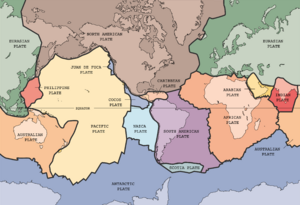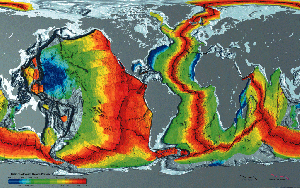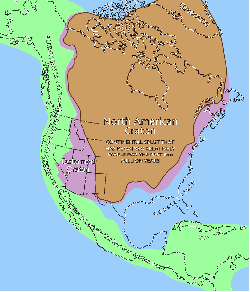Difference between revisions of "Lithosphere" - New World Encyclopedia
(imported latest version of article from Wikipedia) |
(→Continental lithosphere (Continental crust): adding caption to image) |
||
| Line 11: | Line 11: | ||
* [[Continental crust|continental lithosphere]] | * [[Continental crust|continental lithosphere]] | ||
Oceanic lithosphere is about 70 km thick (but can be as thin as 1.6 km at the [[mid-ocean ridge]]s), while continental lithosphere is about 150 km thick (and can be considerably thicker at continental collision zones). Oceanic lithosphere consists mainly of [[mafic]] and [[ultramafic]] rocks and is denser than continental lithosphere, which consists predominantly of [[felsic]] rocks. This higher density has the effect that at [[subduction zone]]s the oceanic plate will invariably sink underneath the continental plate. New oceanic lithosphere is constantly being produced at mid-ocean ridges from mantle material and is recycled back to the mantle at subduction zones. As a result, oceanic lithosphere is much younger than continental lithosphere: the oldest oceanic lithosphere is about 200 million years old, while parts of the continental lithosphere are billions of years old. As oceanic lithosphere grows older, it gets cooler and denser, with the result that if two oceanic plates converge, the older one will subduct below the younger one. | Oceanic lithosphere is about 70 km thick (but can be as thin as 1.6 km at the [[mid-ocean ridge]]s), while continental lithosphere is about 150 km thick (and can be considerably thicker at continental collision zones). Oceanic lithosphere consists mainly of [[mafic]] and [[ultramafic]] rocks and is denser than continental lithosphere, which consists predominantly of [[felsic]] rocks. This higher density has the effect that at [[subduction zone]]s the oceanic plate will invariably sink underneath the continental plate. New oceanic lithosphere is constantly being produced at mid-ocean ridges from mantle material and is recycled back to the mantle at subduction zones. As a result, oceanic lithosphere is much younger than continental lithosphere: the oldest oceanic lithosphere is about 200 million years old, while parts of the continental lithosphere are billions of years old. As oceanic lithosphere grows older, it gets cooler and denser, with the result that if two oceanic plates converge, the older one will subduct below the younger one. | ||
| + | |||
| + | ==Oceanic lithosphere (Oceanic crust)== | ||
| + | [[Image:Earth seafloor crust age 1996.gif|thumb|300px|Age of oceanic crust]] | ||
| + | |||
| + | '''Oceanic crust''' is the part of Earth's [[lithosphere]] which surfaces in the [[ocean]] basins. Oceanic crust is composed of [[mafic]] [[basalt]]ic rocks, or [[Sima (geology)|sima]]. It is thinner, generally less than 10 [[kilometre]]s thick, but more [[density|dense]] than the [[continental crust]], or [[sial]], having a mean density of about 3.3 [[gram]]s per [[cubic centimeter]]. | ||
| + | |||
| + | Most of the present day oceanic crust is less than 200 million years old because it is continuously being created at [[oceanic ridge]]s and destroyed by being pulled back under the continental crust in [[subduction zone]]s by the convection currents in the lower [[Mantle (geology)|mantle]]. [[Plate tectonics]] is the study of these processes. | ||
| + | |||
| + | ==Continental lithosphere (Continental crust)== | ||
| + | [[Image:North america craton nps.gif|right|250px|thumb|North American craton.]] | ||
| + | |||
| + | The '''continental crust''' is the layer of [[granite|granitic]], [[sedimentary]] and [[metamorphic rocks]] which form the [[continent]]s and the areas of shallow seabed close to their shores, known as [[Continental shelf|continental shelves]]. It is less [[dense]] than the material of the Earth's [[Mantle (geology)|mantle]] and thus "floats" on top of it. Continental crust is also less dense than [[oceanic crust]], though it is considerably thicker; 20 to 80 km versus the average oceanic thickness of around 5-10 km. About 40% of the Earth's surface is now underlain by continental crust. | ||
| + | |||
| + | As a consequence of the density difference, when active margins of continental crust meet oceanic crust in [[subduction zone]]s, the oceanic crust is typically [[subducted]] back into the mantle. Because of its relative low density, continental crust is only rarely subducted or re-cycled back into the mantle (for instance, where continental crustal blocks collide and overthicken, causing deep melting). For this reason the oldest rocks on Earth are within the ''[[craton]]s'' or cores of the continents, rather than in repeatedly recycled [[oceanic crust]]; the oldest continental rock is the [[Acasta Gneiss]] at 4.01 [[Annum|Ga]], while the oldest oceanic crust is of [[Jurassic]] age. | ||
| + | |||
| + | The height of mountain ranges is usually related to the thickness of crust. This results from the [[isostasy]] associated with [[orogeny]] (mountain formation). The crust is thickened by the compressive forces related to [[subduction]] or continental collision. The buoyancy of the crust forces it upwards, the forces of the collisional stress balanced by gravity and erosion. This forms a keel or mountain root beneath the mountain range, which is where the thickest crust is found. | ||
| + | |||
| + | The thinnest continental crust is found in [[rift]] zones, where the crust is thinned by [[fault (geology)|detachment faulting]] and eventually severed, replaced by [[oceanic crust]]. The edges of continental fragments formed this way (both sides of the [[Atlantic Ocean]], for example) are termed [[passive margin]]s. | ||
| + | |||
| + | It is a matter of debate whether the amount of continental crust has been increasing, decreasing, or remaining constant over geological time. One model indicates that at prior to 3.7 Bya continental crust contituted less than 10% of the present amount. By 3.0 Bya the amount was about 25% and following a period of rapid crustal evolution it was about 60% of the current amount by 2.6 Bya (Taylor and McLennan, 1995). The growth of continental crust appears to have occurred in ''spurts'' of increased activity corresponding to five episodes of increased production through geologic time (see graphic at [http://earth.leeds.ac.uk/assyntgeology/extra_info/ehistory.htm Butler]). | ||
== References == | == References == | ||
| + | |||
* [http://www.windows.ucar.edu/cgi-bin/tour_def/earth/interior/earths_crust.html Earth's Crust, Lithosphere and Asthenosphere] | * [http://www.windows.ucar.edu/cgi-bin/tour_def/earth/interior/earths_crust.html Earth's Crust, Lithosphere and Asthenosphere] | ||
* [http://www.geolsoc.org.uk/template.cfm?name=lithosphere Crust and Lithosphere] | * [http://www.geolsoc.org.uk/template.cfm?name=lithosphere Crust and Lithosphere] | ||
* Stanley Chernicoff and Donna Whitney. ''Geology. An Introduction to Physical Geology'', 4th ed., Pearson 2007 | * Stanley Chernicoff and Donna Whitney. ''Geology. An Introduction to Physical Geology'', 4th ed., Pearson 2007 | ||
| + | |||
| + | *Butler, Rob, ''Making new continents'', http://earth.leeds.ac.uk/assyntgeology/extra_info/ehistory.htm Accessed 01/29/2006 | ||
| + | *Saal, A.L., Rudnick R.L., Ravizza G.E. & Hart S.R., 1998. ''Re-Os [[isotope geochemistry|isotope]] evdence for the composition, formation and age of the lower crust.'' Nature, 39317, 1998. | ||
| + | *Taylor and McLennan, 1995, ''Model of growth of continental crust through time'' in John Victor Walther, 2005, ''Essentials Of Geochemistry'', Jones & Bartlett, ISBN 0763726427 | ||
| + | *von Huene, R. and D.W. Scholl, 1991. "Observations at convergent margins concerning sediment subduction, subduction erosion, and the growth of continental crust." Reviews of Geophysics, 29, 279-316. | ||
| + | |||
| + | ==External links== | ||
| + | |||
| + | *[http://www.geo.cornell.edu/geology/classes/geochemdata/CrustalAbundances.html Average composition of Continental Crust] | ||
| + | *[http://quake.wr.usgs.gov/research/structure/CrustalStructure Crust 5.1] | ||
==See also== | ==See also== | ||
| + | |||
*[[Asthenosphere]] | *[[Asthenosphere]] | ||
| + | *[[Earth]] | ||
*[[Earth's atmosphere]] | *[[Earth's atmosphere]] | ||
*[[Biosphere]] | *[[Biosphere]] | ||
| Line 26: | Line 59: | ||
*[[Plate tectonics]] | *[[Plate tectonics]] | ||
| + | [[Category:Physical sciences]] | ||
| + | [[Category:Earth sciences]] | ||
[[Category:Geology]] | [[Category:Geology]] | ||
[[Category:Plate tectonics]] | [[Category:Plate tectonics]] | ||
[[Category:Physical geography]] | [[Category:Physical geography]] | ||
| − | + | {{credit3|Lithosphere|56979503|Oceanic_crust|57958902|Continental_crust|54702418}} | |
| − | |||
| − | |||
| − | |||
| − | |||
| − | |||
| − | |||
| − | |||
| − | |||
| − | |||
| − | |||
| − | |||
| − | |||
| − | |||
| − | |||
| − | |||
| − | |||
| − | |||
| − | |||
| − | |||
| − | |||
| − | |||
Revision as of 19:43, 16 June 2006
The lithosphere (from the Greek for "rocky" sphere) is the solid outermost shell of a rocky planet. On the Earth, the lithosphere includes the crust and the uppermost layer of the mantle (the upper mantle or lower lithosphere) which is joined to the crust.
As the cooling surface layer of the Earth's convection system, the lithosphere thickens over time. It is fragmented into relatively strong pieces, called tectonic plates (shown in the picture), which move independently relative to one another. This movement of lithospheric plates is described as plate tectonics.
The distinguishing characteristic of the lithosphere is not composition, but its flow properties. Under the influence of the low-intensity, long-term stresses that drive plate tectonic motions, the lithosphere responds essentially as a rigid shell and thus deforms primarily through brittle failure, whereas the asthenosphere (the layer of the mantle below the lithosphere) is heat-softened and accommodates strain through plastic deformation. Both the crust and upper mantle float on the more plastic asthenosphere. The crust is distinguished from the upper mantle by the change in chemical composition that takes place at the Moho discontinuity.
There are two types of lithosphere:
- oceanic lithosphere
- continental lithosphere
Oceanic lithosphere is about 70 km thick (but can be as thin as 1.6 km at the mid-ocean ridges), while continental lithosphere is about 150 km thick (and can be considerably thicker at continental collision zones). Oceanic lithosphere consists mainly of mafic and ultramafic rocks and is denser than continental lithosphere, which consists predominantly of felsic rocks. This higher density has the effect that at subduction zones the oceanic plate will invariably sink underneath the continental plate. New oceanic lithosphere is constantly being produced at mid-ocean ridges from mantle material and is recycled back to the mantle at subduction zones. As a result, oceanic lithosphere is much younger than continental lithosphere: the oldest oceanic lithosphere is about 200 million years old, while parts of the continental lithosphere are billions of years old. As oceanic lithosphere grows older, it gets cooler and denser, with the result that if two oceanic plates converge, the older one will subduct below the younger one.
Oceanic lithosphere (Oceanic crust)
Oceanic crust is the part of Earth's lithosphere which surfaces in the ocean basins. Oceanic crust is composed of mafic basaltic rocks, or sima. It is thinner, generally less than 10 kilometres thick, but more dense than the continental crust, or sial, having a mean density of about 3.3 grams per cubic centimeter.
Most of the present day oceanic crust is less than 200 million years old because it is continuously being created at oceanic ridges and destroyed by being pulled back under the continental crust in subduction zones by the convection currents in the lower mantle. Plate tectonics is the study of these processes.
Continental lithosphere (Continental crust)
The continental crust is the layer of granitic, sedimentary and metamorphic rocks which form the continents and the areas of shallow seabed close to their shores, known as continental shelves. It is less dense than the material of the Earth's mantle and thus "floats" on top of it. Continental crust is also less dense than oceanic crust, though it is considerably thicker; 20 to 80 km versus the average oceanic thickness of around 5-10 km. About 40% of the Earth's surface is now underlain by continental crust.
As a consequence of the density difference, when active margins of continental crust meet oceanic crust in subduction zones, the oceanic crust is typically subducted back into the mantle. Because of its relative low density, continental crust is only rarely subducted or re-cycled back into the mantle (for instance, where continental crustal blocks collide and overthicken, causing deep melting). For this reason the oldest rocks on Earth are within the cratons or cores of the continents, rather than in repeatedly recycled oceanic crust; the oldest continental rock is the Acasta Gneiss at 4.01 Ga, while the oldest oceanic crust is of Jurassic age.
The height of mountain ranges is usually related to the thickness of crust. This results from the isostasy associated with orogeny (mountain formation). The crust is thickened by the compressive forces related to subduction or continental collision. The buoyancy of the crust forces it upwards, the forces of the collisional stress balanced by gravity and erosion. This forms a keel or mountain root beneath the mountain range, which is where the thickest crust is found.
The thinnest continental crust is found in rift zones, where the crust is thinned by detachment faulting and eventually severed, replaced by oceanic crust. The edges of continental fragments formed this way (both sides of the Atlantic Ocean, for example) are termed passive margins.
It is a matter of debate whether the amount of continental crust has been increasing, decreasing, or remaining constant over geological time. One model indicates that at prior to 3.7 Bya continental crust contituted less than 10% of the present amount. By 3.0 Bya the amount was about 25% and following a period of rapid crustal evolution it was about 60% of the current amount by 2.6 Bya (Taylor and McLennan, 1995). The growth of continental crust appears to have occurred in spurts of increased activity corresponding to five episodes of increased production through geologic time (see graphic at Butler).
ReferencesISBN links support NWE through referral fees
- Earth's Crust, Lithosphere and Asthenosphere
- Crust and Lithosphere
- Stanley Chernicoff and Donna Whitney. Geology. An Introduction to Physical Geology, 4th ed., Pearson 2007
- Butler, Rob, Making new continents, http://earth.leeds.ac.uk/assyntgeology/extra_info/ehistory.htm Accessed 01/29/2006
- Saal, A.L., Rudnick R.L., Ravizza G.E. & Hart S.R., 1998. Re-Os isotope evdence for the composition, formation and age of the lower crust. Nature, 39317, 1998.
- Taylor and McLennan, 1995, Model of growth of continental crust through time in John Victor Walther, 2005, Essentials Of Geochemistry, Jones & Bartlett, ISBN 0763726427
- von Huene, R. and D.W. Scholl, 1991. "Observations at convergent margins concerning sediment subduction, subduction erosion, and the growth of continental crust." Reviews of Geophysics, 29, 279-316.
External links
See also
- Asthenosphere
- Earth
- Earth's atmosphere
- Biosphere
- Cryosphere
- Hydrosphere
- Pedosphere
- Plate tectonics
Credits
New World Encyclopedia writers and editors rewrote and completed the Wikipedia article in accordance with New World Encyclopedia standards. This article abides by terms of the Creative Commons CC-by-sa 3.0 License (CC-by-sa), which may be used and disseminated with proper attribution. Credit is due under the terms of this license that can reference both the New World Encyclopedia contributors and the selfless volunteer contributors of the Wikimedia Foundation. To cite this article click here for a list of acceptable citing formats.The history of earlier contributions by wikipedians is accessible to researchers here:
The history of this article since it was imported to New World Encyclopedia:
Note: Some restrictions may apply to use of individual images which are separately licensed.


